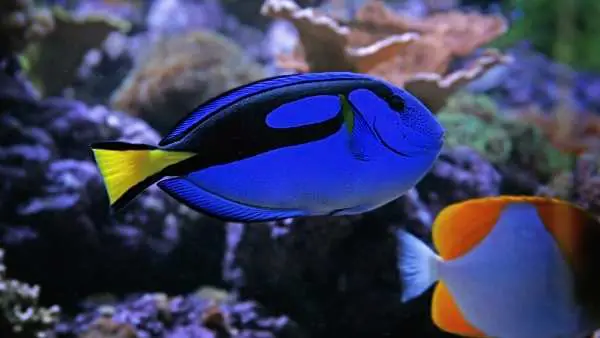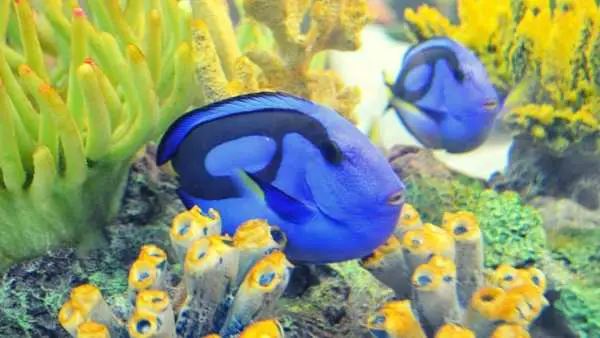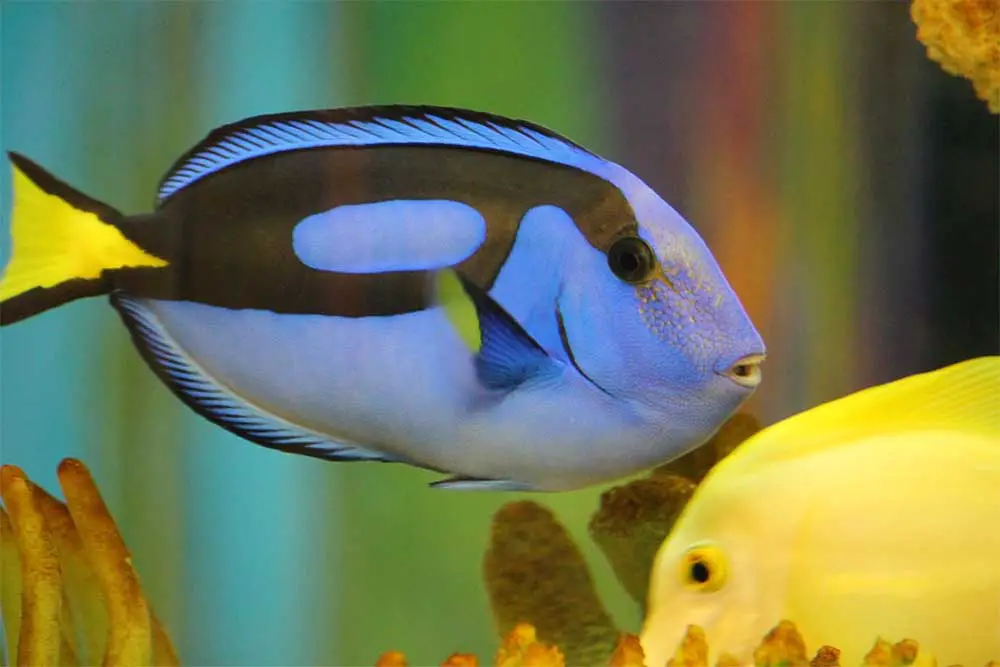When life gets you down, you know why you’ve got to do? Keep swimming - Finding Dory
Thanks to Pixar and their films that celebrated life below the ocean waves, Finding Nemo and Finding Dory the blue tang became an overnight celebrity and a fish that every experienced fishkeeper wanted to add to their tank.
Native to the Caribbean, and found swimming around and diving in out of the many reefs that litter the sea between Florida and Belize, the blue tang (Acanthurus coeruleus) goes by many different names (including the blue doctor and the blue barber) but is most commonly known as the blue tang.

This species of surgeonfish hammered its way into the public consciousness as Dory, the breakout star of the aforementioned films, was a Blue Tang. While the character on screen bore little resemblance to the way that the fish she was portraying actually behave and interact with other fish in the real world, Dory did ensure that the whole world knew what a blue tang was, and what this species of surgeonfish looked like.
Appearances can be deceptive though, and while you could spend hours watching this beautiful fish swim around in your tank, letting it loose in your aquarium poses its own set of problems as this unique surgeonfish has a host of personality quirks and requirements that you‘ll need to accommodate if you want it to thrive and survive. And, to ensure that it does, we’re going to tell you everything that you need to know about the blue tang.
The Perfect Blue Tang Tank Setup
Blue Tangs require the right amount of room and heat to flourish, and the conditions inside your tank will need to match those of their native environment.
The species needs room to move and roam, and due to the fact that they can grow to be big by surgeonfish standards they shouldn’t really be kept in any tank that’s less than four feet in length and ideally, the tank should be able to hold at least 100 gallons (454 liters).
They need room to move, as they have a tendency to wander especially if you intend to keep more than one Blue Tang. When they’re in schools, they tend to forgo their territorial nature and act for the good of the whole instead of the individual members of the school.
Temperature Requirements
The temperature of the water also needs to mimic their natural climate and should be maintained at a range of 73 and 82°F (23 - 28°C), and the heater should always be on. Once you have established the right temperature for your tank, you should not allow the temperature to drop more than one or two degrees below what it is.
You can manage the temperature of your blue tang aquarium easily by using a digital temperature thermometer, but make sure that you acquire a reliable one!
Creating A Tang-Friendly Environment
As they tend to spend a lot of their lives around reefs in the wild, it’s also imperative that you include adequate rockwork in your tank, and that it has enough holes and tunnels for the fish to swim in and out of and hide when they feel they need to.

Rock work provides a perfect foothold for algae to grow, especially in the water temperate that blue tang's require, however, you will not have to worry about cleaning your tank any extra than usual as these guys have a keen apetite for aquarium algae.
Temperament and Compatability
The Blue Tang is, as we’ve already mentioned, a member of the larger surgeonfish family, but that doesn’t mean that they can be housed in the same tank as other surgeonfish. The Blue Tang is a naturally semi-aggressive fish, and can fight for dominance in any area it calls home, a facet of its behavior that’s controlled by its occasional territorial instincts.
So, the best thing to do if you do not want any fighting or casualties within your saltwater fish community is introduce your blue tang last, at least a couple of months after the tank has been established and the community members have established their terratories. If you do this, you will likely not run into any issues.
Fortunately, when it comes to picking blue tang tank mates, we have you covered with our comprehensive blue tang tank mates guide - check it out for inspiration!
Introducing Blue Tang To Your Tank
When you introduce any Blue Tang to your tank, it needs to be done slowly and methodically, as they often exhibit aggression toward other fish, but providing they’re added carefully, they can, and will interact and live with other species of fish. So, yes you can replicate Finding Nemo in the comfort of your own home, as Blue Tang and Clownfish can happily share the same living space.
It’s Dinner Time - Feeding Your Blue Tang
Blue tangs typically have extremely quick metabolisms that carry through even to an old age, so, we would recommend feeding them once a day, regardless of their age. We would also suggest skipping one day of feeding perhaps once every two weeks, this is good for their digestive systems to have a day off and will also encourage them to eat algae and even harmful tank bacterias.
Blue tangs are omnivorous but tend to favor a meat-rich diet, so, try and feed them a balanced diet consisting of frozen or dried meats such as bloodworms or brine shrimp, with the addition of vegetable and algae wafers or pellets.
Blue tangs are also more than a little enamored with seaweed, and will also happily eat it if it’s available to them. Something important to note is that blue tangs, like many other colorful fish, will lose their coloration if they are not being fed a balanced and healthy diet.
Hardiness and Life Expectancy
Blue Tangs like every member of their genus are susceptible to skin diseases and fin rot, but as long as the water in your tank is kept at the right temperature, is clean, and constantly maintained they should be fine.
They do however live for a surprisingly long time, and it isn’t uncommon for blue tang to live for up to 25 years in captivity, so you’ll need to be prepared for the fact that keeping, and looking after blue tang is certainly a long term commitment that shouldn’t be taken lightly.
Extra Blue Tang Facts and Information
The blue tang has a well-developed sense of self-preservation and when it’s being hunted by larger, carnivorous fish and predators in the wild, the blue tang plays dead. It’ll float on its side, or lie on the bottom of the ocean and won’t move until it’s sure that any danger has passed and it’s safe for it to start moving again.
As it will only engage in this behavior if it believes that it is being threatened, the chances of seeing one “play dead” while they’re in a tank are slim to non-existent as they won’t be plagued, or feel threatened by any natural predators.

The Blue Tang’s Poison Touch
The blue tang like every member of its genus has a caudal spine, which emerges when the fish is agitated or excited. If you are stung by this spine, even though it'll be extremely painful for a number of hours after the initial sting, it isn’t poisonous.
While some members of the surgeonfish family do possess poison glands and sacs, the blue tang isn’t one of them. The sting is painful, but it isn’t poisonous.
Even though their sting isn’t poisonous, their flesh can be. Blue Tangs are regarded as being low-value catch by fishermen, as they can’t and shouldn’t be eaten by humans. Long-term exposure to toxins within the fish’s natural reef environment, while not dangerous to the fish, can be deadly to anyone who tries to eat them.
Reasons Not To Keep A Blue Tang
While it’s an alluring and beautiful fish to watch, there are some of reasons as to why the blue tang shouldn’t be kept in captivity. And none of them have anything to do with the blue tang being an endangered species, as it isn’t an endangered fish and continues to prosper in its natural environment.
Aggressiveness
As it’s a semi-aggressive fish, introducing a blue tang into your tank, regardless of how carefully you do it, poses a slight risk to any other fish who might already be living there. They can attack any other residents of your tank, which won’t end well for either party. Fortunately, this isn't a common occurrence, but still a possibility if you do not set them up correctly.
Large Tank Size Requirement
In addition to their semi-aggressive tendancies, they’re far from easy to look after and take care of and you’ll have to be constantly involved in the maintenance of your tank if you do want to keep them.
Then there’s the size requirement of the tank that you’ll need to keep a blue tang and the expense of actually buying them. If you don’t have the room for a large tank in your home, you’d be better off looking at a different species to populate your aquarium with and forgetting about trying to keep these reassuringly expensive fish.

Breeding Issues
The final reason you may reconsider keeping blue tangs is that the fish doesn’t breed in captivity, which means that every blue tang that’s swimming around in a tank was captured in the wild and sold to a pet shop or specialist supplier before it made its way to whoever bought it.
Our Final Thoughts
Despite the clear challenges that you will face if you want to successfully keep your very own blue tang (Dory), they are undoubtedly one of the most rewarding fish to own in the hobby, with extremely unique appearances and personalities. You will need to be experienced in saltwater fishkeeping and own a large enough tank to accomodate them, but if you do, we highly recommend challenging yourself with one of the best fish in the hobby, good luck!
